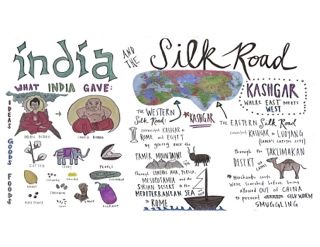Kitchen Humanities: Silk Road II - Indian Vegetable Curry

Summary
In this 6th grade humanities lesson, students prepare Vegetable Curry as they study the ideas, goods, and foods that India shared with other regions along the Silk Road. This is the second of four Silk Road lessons.
Objectives
After this lesson, students will be able to:
- Cite examples of India’s contributions to the Silk Road
- Describe the Silk Road
- Identify ingredients and practice tasting the results of the recipe
- Make connections between the diets of historic cultures and foods we eat today
Assessments
During this lesson, students will:
- Name ideas, goods, and foods from India that were traded along the Silk Road
- Identify the Silk Road as a network of trade routes, and describe the terrains and methods of transportation used by travelers
- Measure, toast, grind, and combine spices for the Vegetable Curry and flavor the dish according to their preferences
- Make connections between the diets of historic cultures and foods we eat today
Materials
For the Chef Meeting
- Vegetable Curry recipe
- Curry Spice Mix recipe
- Ingredients and tools for demonstration
- Traditional Indian Music recording
- Music player
- Visual aid
Ingredients
- Basmati rice
For the Curry Spice Mix
- Coriander seeds
- Cardamom pods
- Mustard seeds
- Black peppercorns
- Cumin seeds
- Chili flakes
- Ground turmeric
Vegetable Curry
- Olive oil
- Onion
- Curry Spice Mix
- Carrots
- Potatoes
- Garbanzo beans
- Coconut milk
- Vegetable stock
- Assorted greens
- Salt
- Pepper
Tools
- Cast Iron Skillet
- Heavy bottomed pot
- Vegetable peeler
- Mortar and pestle
- Wooden spoon
- Chefs’ knives
- Paring knives
- Cutting boards
- Measuring beaker
- Measuring cups
- Measuring spoons
Equipment
- Stove
Before You Begin
- Collect all the tools and ingredients, and then distribute them to the tables
- Gather supplies for the Chef Meeting
- Create the visual aid
- Copy the Curry Spice Mix recipe to hand out
- Copy the Vegetable Curry recipe to hand out
- Select music and set up audio player
- Prepare the vegetable stock (if possible, use stock made in an earlier class)
- Boil or steam the potatoes
- Cook the rice
- Cook the garbanzo beans
Procedures
At the Chef Meeting
- Play music as students silently enter the classroom.
- Welcome students and review the Steamed Dumplings recipe from the previous lesson, and China’s role on the Silk Road. Tell students that today they will be traveling to the city of Kashgar, which was a central meeting place for the three main regions of the Silk Road: China, India and Rome.
- Use a rainbow chard leaf to illustrate that the Silk Road was not a single road, but many. Show how the veins of the leaf connect to the main stem, in the same way that minor routes of the Silk Road connected to the main route.
- Use the visual aid to review the goods, ideas and foods that China traded along the Silk Road. Ask students to think back to China’s silk and what made it so valuable to trade, and then remind them that because of the harsh physical terrain, light and packable items were ideal trading goods.
- Ask students to use the visual aid to identify the languages, religion, technology, and music that India contributed to trade along the Silk Road. Also ask them which goods, ideas, and foods originated in India and traveled along the Silk Road. Explain that spices contributed not only to trade, but also to culture, as they influenced people’s diets.
- Identify the city of Kashgar and explain its importance to the Silk Road. It was the central trading point where Eastern and Western trade routes met, by connecting three major empires of the Ancient world: India, China, and Rome.
- Tell students that in Kashgar the terrain became mountainous and travelers could not continue on camels because the mountains were too treacherous, so their camels were exchanged for Yak. This part of the route was so deadly that many humans and animals lost their lives, and it became known as the “Trail of Bones”.
- Explain one more reason Kashgar is important: the western Silk Road connected Kashgar to the Mediterranean through Persia, by going over the Pamir Mountains, through Mesopotamia, and across the Syrian Desert. Once goods reached the Mediterranean they were taken by ship to Rome.
- Introduce curry, and point out that people all over the world make curry. Curry is a combination of spices, and the recipe is often changed depending on the region in which it is prepared. Today’s Curry Spice Mix is based on a traditional Indian mix of spices that were traded along the Silk Road.
- Ask students to wash their hands and join their table group.
At the Table
- Meet with the table groups to review the recipe and assign jobs. Demonstrate how each ingredient will be prepared.
- Prepare the recipe.
- Set the table; eat; clean up.
At the Closing Circle
Name one item that China or India contributed to trade along the Silk Road.
Vocabulary
Curry